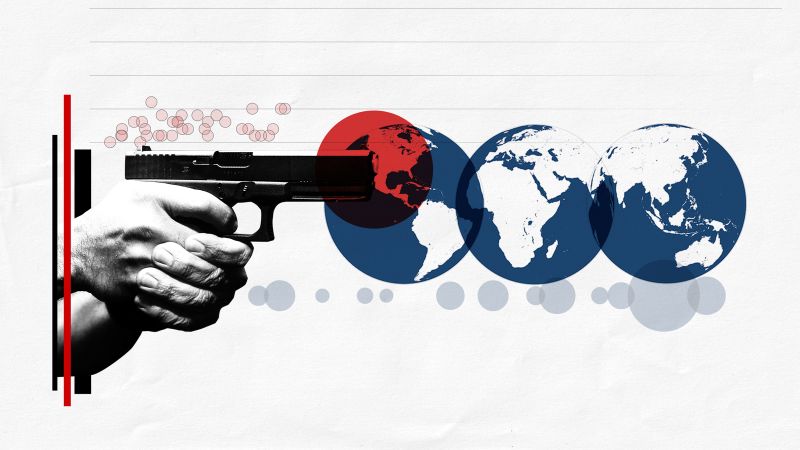Lewiston. Monterey Park. Orlando. Las Vegas. Newtown. Parkland. San Bernardino. Uvalde. Nashville. Louisville.
Ubiquitous gun violence in the United States has left few places unscathed over the decades. Still, many Americans hold their right to bear arms, enshrined in the US Constitution, as sacrosanct. But critics of the Second Amendment say that right threatens another: The right to life.
America’s relationship to gun ownership is unique, and its gun culture is a global outlier.
As the tally of gun-related deaths continue to grow daily, here’s a look at how gun culture in the US compares to the rest of the world.
There are 120 guns for every 100 Americans, according to the Switzerland-based Small Arms Survey (SAS). No other nation has more civilian guns than people.
The Falkland Islands – a British territory in the southwest Atlantic Ocean, claimed by Argentina and the subject of a 1982 war – is home to the world’s second-largest stash of civilian guns per capita. But with an estimated 62 guns per 100 people, its gun ownership rate is almost half that of the US. Yemen – a country in the throes of a seven-year conflict – has the third-highest gun ownership rate at 53 guns per 100 people.
While the exact number of civilian-owned firearms is difficult to calculate due to a variety of factors – including unregistered weapons, the illegal trade and global conflict – SAS researchers estimate that Americans own 393 million of the 857 million civilian guns available, which is around 46% of the world’s civilian gun cache.
About 44% of US adults live in a household with a gun, and about one-third own one personally, according to an October 2020 Gallup survey.
Some nations have high gun ownership due to illegal stocks from past conflicts or lax restrictions on ownership, but the US is one of only three countries in the world where bearing (or keeping) arms is a constitutional right, according to Zachary Elkins, associate professor of government at the University of Texas at Austin and director of the Comparative Constitutions Project. Yet the ownership rate in the other two – Guatemala and Mexico – is almost a tenth of the United States.
The gun debate in those countries is less politicized, Elkins said. In contrast to the US, Guatemala and Mexico’s constitutions facilitate regulation, with lawmakers more comfortable restricting guns, especially given concerns around organized crime, he said. In Mexico, there’s only one gun store in the entire country – and it’s controlled by the army.
In the US, firearm manufacturing is on the rise, with more Americans buying guns.
In 2018, gun makers produced 9 million firearms in the country – more than double the amount manufactured in 2008, according to the US Bureau of Alcohol, Tobacco, Firearms and Explosives (ATF). More recently, January 2021 marked the biggest annual increase since 2013 in requests for federal background checks necessary for purchasing a gun – a nearly 60% jump from January 2020.
And in March 2021, the FBI reported almost 4.7 million background checks – the most of any month since the agency started keeping track more than 20 years ago. Two million of those checks were for new gun purchases, making it the second highest month on record for firearms sales, according to the National Shooting Sports Federation, the firearms industry trade group that compares FBI background check numbers with actual sales data to determine its sales figures.
Almost a third of US adults believe there would be less crime if more people owned guns, according to an April 2021 Pew survey. However, multiple studies show that where people have easy access to firearms, gun-related deaths tend to be more frequent, including by suicide, homicide and unintentional injuries.
It is then unsurprising that the US has more deaths from gun violence than any other developed country per capita. The rate in the US is eight times greater than in Canada, which has the seventh highest rate of gun ownership in the world; 22 times higher than in the European Union and 23 times greater than in Australia, according to Institute for Health Metrics and Evaluation (IHME) data from 2019.
The gun-related homicide rate in Washington, DC – the highest of any US state or district – is close to levels in Brazil, which ranks sixth highest in the world for gun-related homicides, according to the IHME figures.
Globally, countries in Latin America and the Caribbean suffer from the highest rates of firearm homicides, with El Salvador, Venezuela, Guatemala, Colombia and Honduras topping the charts.
Drug cartel activities and the presence of firearms from old conflicts are both contributing factors, according to the 2018 Global Mortality From Firearms, 1990-2016, study.
But gun-related violence in Latin America and the Caribbean is also exacerbated by weapons that come from the US. About 200,000 firearms from America cross Mexico’s border every year, according to a February 2021 US government accountability office report, citing the Mexican government.
In 2019, about 68% of firearms seized by law enforcement in Mexico and sent to the ATF for identification were traced back to the US. And around half of guns the ATF checked after they’ve been seized in Belize, El Salvador, Honduras and Panama were manufactured in or officially imported to the US.
While personal safety tops the list of reasons why American gun owners say they own a firearm, 63% of US gun-related deaths are self-inflicted.
Over 23,000 Americans died from self-inflicted gunshot wounds in 2019. That number accounts for 44% of the gun suicides globally and dwarfs suicide totals in any other country in the world.
At six firearm suicides per 100,000 people, the US rate of suicide is, on average, seven times higher than in other developed nations. Globally, the US rate is only lower than in Greenland, an autonomous Danish territory with relatively high gun ownership (22 guns per 100 people).
Multiple studies have reported an association between gun ownership and gun-related suicides.
One of those studies, conducted by researchers at Stanford University, found that men who owned handguns were almost eight times as likely to die of self-inflicted gunshot wounds as men who didn’t own a gun. Women who owned handguns were 35 times as likely to die by firearm suicide, compared to those who didn’t, according to the 2020 study, which surveyed 26 million California residents over a more than 11-year period.
Regular mass shootings are a uniquely American phenomenon. The US is the only developed country where mass shootings have happened every single year for the past 20 years, according to Jason R. Silva, an assistant professor of sociology and criminal justice at William Paterson University.
To compare across countries, Silva uses a conservative definition of a mass shooting: an event that leaves four or more people dead, excluding the shooter, and that excludes profit-driven criminal activity, familicide and state-sponsored violence. Using this approach, 68 people were killed and 91 injured in eight public shootings in the US over the course of 2019 alone.
A broader definition of mass shootings reveals an even higher figure.
They counted as many as 417 mass shootings in 2019. And in 2022, 213 mass shootings have already been recorded.
State gun policies also appear to play a role. A 2019 study published in the British Medical Journal found that US states with more permissive gun laws and greater gun ownership had higher rates of mass shootings.
US President Joe Biden’s administration renewed calls for gun reform after mass shootings in Colorado, South Carolina and Texas last year. In March 2021, the House of Representatives passed legislation that would require unlicensed and private sellers, as well as all licensed sellers to do federal background checks before all gun sales – and to ensure that buyers are fully vetted before making the sale.
The bills are now stuck in the Senate where, despite some Democrats’ efforts to build bipartisan support, there has been no indication they have the votes to overcome the 60-vote filibuster.
For decades, political roadblocks have stalled such efforts in the US. And that partisan divide is reflected in the population as well, with 80% of Republicans – and 19% of Democrats – saying gun laws in the country are either about right or should be less strict, according to the April Pew survey.
Meanwhile, mass shootings continue to drive demand for more guns, experts say, with gun control activists arguing the time for reform is long overdue.
Researchers from Washington University at St Louis’ Whitney R. Harris World Law Institute presented this argument to the Inter-American Commission on Human Rights in 2018, saying that the US government’s “failure” to prevent and reduce gun-related violence through “reasonable and effective domestic measures has limited the ability of Americans to enjoy many fundamental freedoms and guarantees protected by international human rights law,” including the right to life and bodily integrity.
UN bodies have also underlined these concerns, pointing to America’s “stand your ground” laws, which allow gun owners in at least 25 states to use deadly force in any situation where they believe that they face an imminent threat of harm, without first making any effort to deescalate the situation or retreat. A 2019 United Nations High Commissioner for Human Rights report said that the law can encourage people to respond to situations with lethal force, rather than use it as a last resort.
In a 2020 essay published by the Center for American Progress, a liberal Washington think tank, gun control advocate Rukmani Bhatia said that the US gun lobby has seized a rights-based narrative “to justify, dangerously, the right to bear, carry, and use firearms.”
Stand your ground legislation, she said, “warps people’s understanding about their rights to security and, in the worst cases, empowers them to take away another person’s right to life.”
Meanwhile, countries that have introduced laws to reduce gun-related deaths have achieved significant changes.
A decade of gun violence, culminating with the Port Arthur massacre in 1996, prompted the Australian government to take action.
Less than two weeks after Australia’s worst mass shooting, the federal government implemented a new program, banning rapid-fire rifles and shotguns, and unifying gun owner licensing and registrations across the country. In the next 10 years gun deaths in Australia fell by more than 50%. A 2010 study found the government’s 1997 buyback program – part of the overall reform – led to an average drop in firearm suicide rates of 74% in the five years that followed.
Other countries are also showing promising results after changing their gun laws. In South Africa, gun-related deaths almost halved over a 10-year-period after new gun legislation, the Firearms Control Act of 2000, went into force in July 2004. The new laws made it much more difficult to obtain a firearm.
In New Zealand, gun laws were swiftly amended after the 2019 Christchurch mosque shootings. Just 24 hours after the attack, in which 51 people were killed, Prime Minister Jacinda Ardern announced that the law would change. New Zealand’s parliament voted almost unanimously to change the country’s gun laws less than a month later, banning all military-style semi-automatic weapons.
Britain tightened its gun laws and banned most private handgun ownership after a mass shooting in 1996, a move that saw gun deaths drop by almost a quarter over a decade. In August 2021, a licensed firearms holder killed five people in Plymouth, England, marking the worst mass shooting since 2010. After the incident, police said the gunman’s firearm license had been returned to him just months after it was revoked, due to assault accusations. The British government then asked police to review their licensing practices and said that they would be bringing forward new guidance to improve background procedures, including social media checks.
Many countries around the world have been able to tackle gun violence. Yet, despite the thousands of lost lives in the US, only around half of US adults favor stricter gun laws, according to the recent Pew survey, and political reform remains at a standstill. The deadly cycle of violence seems destined to continue.
How CNN reported this story:
When comparing US statistics with other developed countries we used a UN definition found in the United Nations’ World Economic Situation and Prospects report – which intends “to reflect basic economic country conditions” and is not strictly aligned with the UN Statistics Division’s classification known as M49.
This story has been updated.







































